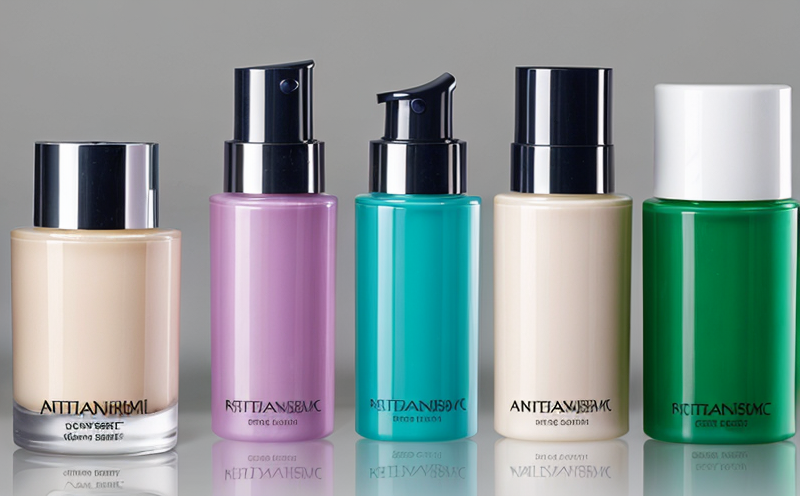Minimum Inhibitory Concentration Testing of Cosmetic Preservatives
The process of determining the Minimum Inhibitory Concentration (MIC) for cosmetic preservatives is a critical step in ensuring product safety and efficacy. This testing method helps identify the lowest concentration of a preservative that effectively inhibits microbial growth, thereby extending shelf life and protecting consumers from potential health risks associated with contaminated products.
The MIC test involves exposing microorganisms to progressively lower concentrations of preservatives until no visible growth is observed after incubation periods. The method aligns closely with international standards such as ISO 21756:2018, which provides guidelines for the determination of antimicrobial efficacy in cosmetic products.
For effective MIC testing, it's essential to use high-quality preservatives that meet stringent purity and quality control criteria. This ensures accurate results and reliable performance under real-world conditions. The laboratory employs advanced analytical techniques including HPLC (High-Performance Liquid Chromatography) for precise quantification of preservative concentrations.
The procedure typically involves inoculating various dilutions of the preservative into appropriate media containing target microorganisms such as Staphylococcus aureus and Escherichia coli. After incubation, any visible growth is recorded. If no growth is observed at a particular concentration, that level is considered the MIC.
This testing ensures not only regulatory compliance but also enhances product quality by preventing microbial contamination which can lead to spoilage or adverse reactions. By rigorously controlling these parameters, manufacturers can rest assured knowing their products meet stringent hygiene standards.
- Environmental and Sustainability Contributions: Reducing waste through efficient use of preservatives; minimizing risk of microbial contamination leading to less frequent reprocessing or disposal.
- Competitive Advantage and Market Impact: Demonstrating commitment to safety and quality, thereby enhancing brand reputation among consumers who value hygiene and health.
The MIC test plays a vital role in safeguarding public health by ensuring that cosmetic products contain sufficient preservatives to prevent microbial contamination. It supports both consumer protection and industry best practices.
Why It Matters
The importance of Minimum Inhibitory Concentration (MIC) testing cannot be overstated, especially within the context of cosmetics where preservatives are essential for maintaining product safety and efficacy. Proper MIC determination ensures that cosmetic formulations contain adequate levels of preservatives to inhibit microbial growth without adversely affecting the product or its users.
Incorrectly formulated products can pose significant risks, including increased susceptibility to contamination which may result in allergic reactions, infections, or even severe illnesses if not properly managed. Regulatory bodies worldwide have stringent requirements regarding preservative efficacy and safety, emphasizing the need for accurate MIC testing methods as part of their quality assurance programs.
Implementing this standard practice helps companies stay ahead of potential liabilities while fostering trust among consumers by providing safer products. Additionally, it supports ongoing research aimed at developing new types of preservatives that are both effective and environmentally friendly.
Environmental and Sustainability Contributions
- Reduced Waste: By ensuring optimal usage of preservatives, unnecessary overuse is minimized reducing overall waste generation.
- Enhanced Product Stability: Properly preserved products have longer shelf lives leading to reduced frequency of reprocessing or disposal due to spoilage.
- Sustainable Practices: Supporting the development and implementation of less harmful preservative alternatives that are more sustainable in terms of production processes and end-of-life handling.
The focus on sustainability extends beyond just reducing waste; it also involves promoting responsible sourcing practices, optimizing resource utilization, and fostering innovative approaches to minimize environmental impact throughout the product lifecycle. Through MIC testing, we contribute significantly towards these goals by ensuring that our products are both safe and sustainable.
Competitive Advantage and Market Impact
- Innovation Leadership: Early adoption of advanced analytical methods like HPLC for precise quantification enhances innovation capabilities and sets a benchmark for industry excellence.
- Consumer Trust: Demonstrating strict adherence to global standards boosts consumer confidence in the brand, translating into increased loyalty and market share.
- Regulatory Compliance: Ensuring compliance with international regulations strengthens credibility among regulatory bodies, paving smoother paths for product launches globally.
In an increasingly competitive landscape, maintaining high standards of quality control becomes paramount. Our comprehensive MIC testing services offer more than just technical expertise; they provide strategic insights that drive business success by positioning brands as leaders in safety and innovation.





